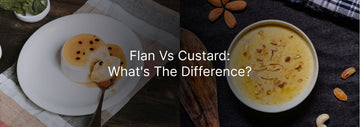Mornings set the tone for the day, and what better way to start than with a delightful treat? Enter flan and custard—too creamy, dreamy options that often grace breakfast tables and dessert menus alike. But what’s the real difference between these two beloved classics? If you’ve ever found yourself pondering whether to go for flan or custard, you’re not alone. Let’s break it down in a friendly, easy-to-digest way that’ll make your next breakfast decision a breeze.
Understanding Custard
First things first, let’s talk about custard. At its core, custard is a creamy concoction made from milk or cream, eggs, sugar, and flavourings like vanilla. It’s incredibly versatile, showing up in everything from pies and tarts to ice creams and pastries.
Types of Custard
1. Stirred Custard: Think of this as the pourable cousin of custard. It’s cooked on the stovetop and stirred constantly until it thickens into a smooth sauce. Perfect for drizzling over desserts like apple pie or a warm brownie.
2. Baked Custard: This version is set in the oven, resulting in a firmer texture. Classic dishes like crème brûlée and, yes, flan fall into this category.
3. Set Custard: Chilled and often mixed with gelatin, set custard is firm yet creamy. It’s the perfect filling for éclairs or as a standalone dessert.
Flan: The Caramel Marvel
Now, let’s shine the spotlight on flan. Often synonymous with crème caramel, flan is a specific type of baked custard that features a luscious caramel topping. Originating from Spain, flan has travelled across continents, adapting to local tastes and becoming a staple in many cultures.
What Makes Flan Special?
1. Caramel Delight: Flan’s defining feature is its caramel layer. Sugar is melted until it turns golden and then poured into the mould before adding the custard mixture. When inverted, this caramel creates a rich, sweet sauce that perfectly complements the creamy custard.
2. Smooth Texture: Flan is known for its silky, smooth texture. Baking it in a water bath ensures even cooking, preventing cracks and maintaining that flawless consistency.
3. Flavor Flexibility: While traditional flan is flavoured with vanilla, modern variations might include coconut, coffee, or even citrus zest to add a unique twist.
Flan vs. Custard
While flan is a type of custard, several key distinctions set it apart from other custard-based treats. Let’s dive into the specifics:
1.Preparation Method
Custard: This can be made on the stovetop, baked in the oven, or set in the fridge. The method you choose impacts the final texture—ranging from a pourable sauce to a firm pudding.
Flan: Always baked in a water bath. This gentle cooking method ensures a smooth texture and integrates the caramel layer seamlessly.
2. Ingredients and Flavor
Custard: Primarily consists of milk or cream, egg yolks, sugar, and flavourings. It’s a blank canvas that can be customized with various flavours.
Flan: Incorporates the essential custard ingredients but places a spotlight on the caramel topping, adding a sweet and slightly bitter balance to the creamy base.
3. Texture and Consistency
Custard: Can vary widely—from a thin sauce to a thick, pudding-like consistency, depending on how it’s prepared.
Flan: Maintains a consistently smooth and creamy texture, enhanced by the rich caramel sauce when served.
4. Serving Style
Custard: Extremely versatile in how it’s served. It can be poured over desserts, chilled in cups, or used as a filling for pastries.
Flan: Typically served as a standalone dessert. It’s often inverted onto a plate, showcasing the beautiful caramel layer on top.
Flan and Custard Across Cultures
Both flan and custard have made their mark globally, with each culture adding its unique flair.
Flan Around the Globe
-
Spain: The birthplace of flan, where it’s a beloved dessert in homes and restaurants alike.
-
Latin America: Countries like Mexico and the Philippines have their versions—Mexico’s flan might include a hint of cinnamon, while the Philippines’ leche flan is denser and sweeter.
-
France: Known as crème caramel, it’s a classic in French cuisine, often enjoyed with a cup of coffee.
Custard’s Global Footprint
-
United Kingdom: Custard is a staple accompaniment to pies, crumbles, and other desserts, often served warm.
-
Japan: Custard appears in various sweets, from custard-filled pastries to matcha-flavored delights.
-
United States: From the creamy richness of crème brûlée to the smoothness of custard-based ice creams, it’s a versatile ingredient in American desserts.
Crafting the Perfect Flan or Custard at Home
Ready to whip up some homemade goodness? Whether you’re leaning towards the caramel elegance of flan or the versatile charm of custard, here are some tips to ensure your creation turns out just right.
Flan Tips
-
Quality Ingredients: Fresh eggs and high-quality milk or cream make a noticeable difference in flavor and texture.
-
Caramel Care: Melt sugar slowly to achieve a golden caramel without burning. Pour it into the mold while hot to ensure a smooth layer.
-
Water Bath Baking: Baking flan in a water bath prevents cracking and promotes even cooking for that silky texture.
-
Chill Well: Let your flan cool completely in the refrigerator before serving to set perfectly.
Custard Tips
-
Temper the Eggs: Gradually add hot milk to the egg mixture while whisking to prevent curdling.
-
Low and Slow: Cook custard over low heat, stirring constantly to avoid scorching and ensure a smooth texture.
-
Strain for Silkiness: For an extra smooth custard, strain the mixture before serving to eliminate any lumps.
-
Flavour Fun: Don’t be afraid to experiment with different flavours—chocolate, coffee, or even spices like nutmeg can elevate your custard game.
Breakfast Bliss: Flan and Custard in the Morning
While traditionally seen as desserts, flan and custard can be fantastic additions to your breakfast repertoire.
Flan for a Sweet Start
-
Light Indulgence: A slice of flan offers a sweet and creamy start without feeling too heavy.
-
Fruit Pairing: Serve alongside fresh berries or a vibrant fruit salad for a balanced morning treat.
-
Coffee Kick: A drizzle of coffee or a sprinkle of cinnamon can enhance flan’s flavours, pairing perfectly with your morning brew.
Custard for a Creamy Morning
-
Custard Toast: Spread a generous layer of custard over toast or a buttery croissant for a rich and indulgent breakfast option.
-
Smoothie Base: Blend custard with your favorite fruits and a splash of milk for a creamy, nutrient-packed smoothie.
-
Oatmeal Upgrade: Stir a spoonful of custard into your oatmeal to add extra creaminess and a burst of flavor.
Wrapping It Up
Flan and custard are two creamy delights that each brings their unique charm to the table. Flan dazzles with its rich caramel topping and smooth texture, making it a standout dessert that’s perfect for any occasion. Custard, on the other hand, offers incredible versatility, fitting seamlessly into both sweet and savory dishes and adapting to a variety of flavors and textures.
Whether you’re treating yourself to a sweet breakfast or impressing guests with a homemade dessert, understanding the differences between flan and custard can help you choose the perfect option to satisfy your cravings. So, next time you’re planning your menu, consider the delightful worlds of flan and custard. Experiment with flavors, enjoy the creamy textures and savor the rich traditions that make these dishes timeless favorites. Happy cooking!








